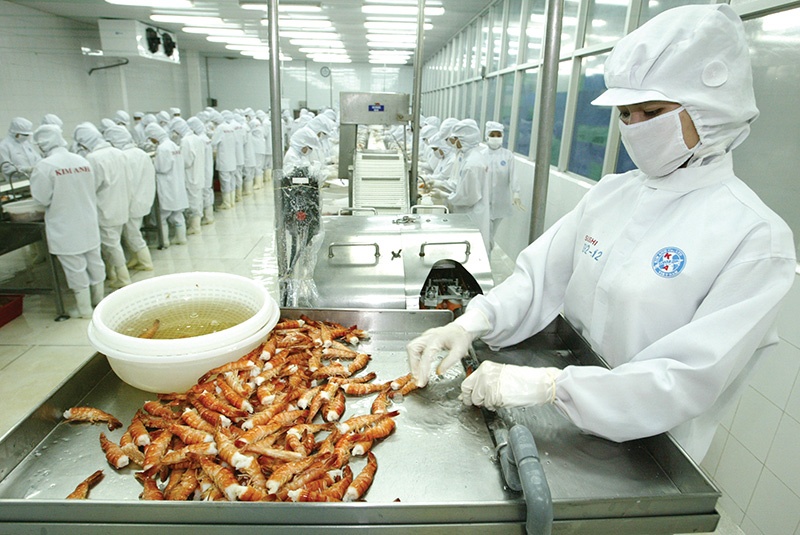More to come from exports in seafood
 |
| Seafood exporters have been looking to secure output markets, Photo: Le Toan |
Prime Minister Pham Minh Chinh delivered a speech to the first Agriculture Sector Review Conference in Hanoi on December 29, 2021, emphasising the mission of the agriculture industry to fight the pandemic together and sustain economic development as well as supply chains.
The PM said that agriculture continues to assert itself as the backbone of the economy. He urged the agricultural industry to “renovate its thinking further to improve quality, build international products, diversify markets, and ensure that next year’s agricultural growth target stays above 3 per cent,” with exports reaching an estimated $50 billion. “If products continue to depend on some markets, it is very easy for the supply chains to break again during crises,” the PM said.
Meanwhile, the overall picture of the fishery sector remains bright, even if there have been some variations during the year. The coverage of vaccines in the Mekong Delta provinces, coupled with the demand for the European and American markets have led to a more positive business for the sector.
Trade between countries remains complicated, and international shipping rates have been persistent since 2020. Climate change factors and shortages of water supplies for the Mekong Delta make aquaculture burdensome. Fisheries and aquaculture businesses have been dealing with increased requirements for food safety and traceability of markets like the EU and battling dwindling aquatic resources.
The world’s seafood markets are increasingly volatile, with the participation of large suppliers making it harder for small Vietnamese suppliers to access diversified markets.
Putting all their eggs in one basket had turned out fatal amid the pandemic, thus many seafood exporters aim for more diversified networks of customers, while still prioritising markets with large consumption capacity.
The long fishing time and high transportation and storage costs make it impossible for Vietnamese tuna to compete with those from the Philippines and other countries in the region. However, the attraction of the European market has led many seafood businesses to spend resources on exploiting the market.
During the implementation process of the trade agreement with the EU (EVFTA), Pham Van Long from the Institute for Economic and Policy Research interviewed several seafood enterprises. Long said only two enterprises confirmed that the export value to the EU market increased in the past year thanks to an increase in orders, the rest reduced the value of export orders to the EU market.
“The decrease in export value is mainly due to the decrease in the number of orders and the increase in production costs. Tighter export conditions and high logistics costs due to the pandemic caused shipping rates to escalate continuously,” Long explained.
Trade between Vietnam and the EU has improved since the EVFTA took effect, with the export turnover reaching a solid $38.5 billion, up 11.3 per cent, according to the General Department of Vietnam Customs.
“Competition challenges in the future are huge, as the EU is also negotiating FTAs with other countries in Southeast Asia, rendering Vietnam’s trade costs higher than those of other countries in the ASEAN region,” Long acknowledged.
The trend shifting global supply chains could bring great opportunities for Vietnamese seafood in diversified markets. For example, penetrating deeper into the South American market would be one option as Vietnam has an FTA with Chile and both are members of the Comprehensive and Progressive Agreement for Trans-Pacific Partnership.
The Vietnam-Chile FTA took effect in 2014. By 2019, the value of Vietnam’s tuna exports to Chile increased from $1.4 million to nearly $10.2 million, an increase of 633 per cent.
However, the number of enterprises actively approaching the Chilean market is not high.
Pham Truong Giang, Vietnamese Ambassador to Chile said that to penetrate deeper, he recommended that products exported to the Chilean market must clearly show hygienic quality, ingredients, nutritional value, and the proportion of ingredients – and all should be printed in Spanish.
Further, Vietnam maintains a competitive advantage in the raw material supply compared to other countries, with stable prices and good-quality seafood products. FTAs will continue to be a lever for Vietnam’s seafood exports to recover in some markets.
What the stars mean:
★ Poor ★ ★ Promising ★★★ Good ★★★★ Very good ★★★★★ Exceptional
Related Contents
Latest News
More News
- Businesses ramp up production as year-end orders surge (December 30, 2025 | 10:05)
- Vietjet chairwoman awarded Labour Hero title (December 29, 2025 | 13:06)
- How to unlock ESG value through green innovation (December 29, 2025 | 10:03)
- AI reshapes media and advertising industry (December 29, 2025 | 08:33)
- FPT and GELEX sign deal to develop blockchain tech for global markets (December 29, 2025 | 08:29)
- Vietnam’s GDP forecast to grow by 9 per cent in 2026 (December 29, 2025 | 08:29)
- Women entrepreneurs are key to Vietnam’s economic growth (December 29, 2025 | 08:00)
- Vietnam's top 500 value-creating enterprises announced (December 27, 2025 | 08:00)
- The PAN Group shaping a better future with ESG strategy (December 26, 2025 | 09:00)
- Masan Consumer officially lists on HSX, marking the next phase of value creation (December 25, 2025 | 13:20)

 Tag:
Tag:





















 Mobile Version
Mobile Version